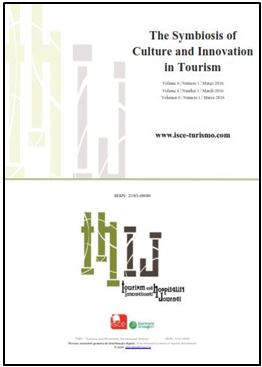Contributos para a compreensão da integração turística no âmbito da interação cultural – os casos da Feira do Cavalo da Golegã e do Comboio Histórico a Vapor no Alto Douro Vinhateiro
DOI:
https://doi.org/10.57883/thij6(1)2016.30283Palavras-chave:
Turismo Cultural, Interação, Integração Turística, Experiência TurísticaResumo
Compreender alguns dos pressupostos e consequências turísticas que assinalam a interação em contextos de Turismo Cultural é o grande objetivo deste artigo. Recorrendo a dois casos de estudo, este trabalho evidencia opções e experiências turísticas distintas, apesar de subsistir em ambos os casos a prevalência de uma interação marcada pelas culturas locais. A interação e consequentes envolvimento e prevalência cultural, por um lado, e, em contraponto, a prevalência de um envolvimento turístico nos atrativos naturais, exorbitando o envolvimento cultural em si, foram vivências observáveis, demonstrando-se que, sendo a interação um mecanismo marcado e tendencialmente propiciador de uma valorização turística cultural, isso não a inibe de proporcionar uma integração turística noutros atrativos da oferta que não os culturais, previamente definidos como objetivo em si próprios. É assim evidenciado o cariz não impositivo da interação enquanto processo cultural de integração turística.
Referências
Almeida, A. S. A. (2008, 19 novembro). Os media entre a assumpção identitária e o imaginário turístico. Apresentada em II Congresso Internacional de Turismo Leiria e Oeste, Peniche, Portugal.
Almeida, A. S. A. (2012). Comunidades turísticas e actores intermediários - A experiência como contributo para a sustentabilidade. In Teatro e Intervenção Social (pp. 97-109). Chaves: Edição Intervenção – Associação para a Promoção e Divulgação Cultural.
Almeida, P. & Araújo, S. (2012). Introdução à gestão de animação turística. Lisboa: Edições Lidel. ISBN: 978-972-757-871-9.
Barañano, A. (2004). Métodos e técnicas de investigação em gestão: Manual de apoio à realização de trabalho de investigação. Lisboa: Edições Sílabo.
Boavida, A. (2012). A experiência turística partilhada – Contributos para a hospitalidade e retenção do destino turístico – O caso da Feira do Cavalo da Golegã. (Dissertação de Mestrado em Gestão e Sustentabilidade no Turismo). Disponível em https://iconline.ipleiria.pt/bitstream/10400.8/665/1/Mestrado%20Gestao%20Sust.Turismo_Ana_Teresa_Boavida.pdf
Cutler, S. & Carmichael, B. (2011). Learning from travel experiences: A system for analyzing reflective learning in journals. In P. Stone, & R. Sharpley, Tourist Experience – Contemporary Perspectives. (1ª Edição, pp. 183-197). Canada: Routledge.
Dias, F. (2009). Visão de síntese sobre a problemática da motivação turística. Percursos & Ideias, 1 (2.ª Série), 117-143.
LEO (2009). Lapland centre of expertise for the experience industry, competitiveness through experiences. Consultado em 18 setembro 2014. Disponível em http://www.leofinland.fi/index.php?name=Content&nodeIDX=3615
Lourenço, E. (2011). Boas práticas de inovação e planeamento em turismo: O caso da Golegã. In Revista Turismo e Desenvolvimento (16), 175-187.
Matos, A., Ribeiro, E. & Bernardo, M. (2009). Caminhos-de-ferro e turismo em Portugal (final do século XIX e primeiras décadas do século XX). Disponível em http://www.cidehus.uevora.pt/textos/artigos/amatos_camferro_turismo_xix-xx.pdf, consultado em 17/10/2011
Moreira, J. (2004). Questionários: Teoria e prática (1ª Edição). Coimbra: Livraria Almedina.
Oliveira, C. (2010). Equestrian tourism in Portugal: Present diagnostic and development prospect. Apresentada em International Congress on Tourism 2010, Porto, Portugal.
Oliveira, P. (2005). A feira da Golegã: Das origens à actualidade, subsídios para a sua história (2.ª Edição). Golegã: Associação Feira Nacional do Cavalo.
Pine, B. & Gilmore, J. H. (1999). The experience economy – Work is theatre & every business a stage. Boston: Harvard Business School Press. ISBN: 9780875848198.
Ryan, C. (2011). Ways of conceptualizing the tourist experience: a review of literature. In P. Stone, & R. Sharpley, Tourist Experience – Contemporary Perspectives (1.ª Edição, pp. 9-20). Canada: Routledge.
Salvador, V. (2012). Experiência turística - Expectativas e vivências metamórficas no desenvolvimento pessoal do turista: O caso do comboio histórico a vapor no Alto Douro Vinhateiro (Dissertação de Mestrado em Gestão e Sustentabilidade no Turismo). Disponível em https://iconline.ipleiria.pt/bitstream/10400.8/646/1/Mestrado%20Gestao%20Sust.Turismo_Vania_Salvador.pdf
Silva, S., Mendes, S. & Almeida, A. (2015). O papel dos museus nos constructos da experiência global do destino - O caso do Museu da Cerâmica de Caldas da Rainha. In Tourism and Hospitality International Journal, 4(1), 48-70.
Smith, V. (Org.). (1989). Hosts and guests: The anthropology of tourism (2.ª Edição). Filadélfia: University of Pennsylvania Press. ISBN: 8-8122-1280-0.
Tarssanen, S. (2006). From service to experience: Experience pyramid, a tool for experience co-creation. Apresentada em Lonnsom Opplevelsesprodukson I Fjellturismen, Oslo, Noruega.
Trigo, L. (2010). A viagem como experiência significativa. In A. Netto & C. Gaeta, Turismo de Experiência (pp. 21-41). São Paulo: Senac. ISBN: 978-85-396-0021-2.
Turner, V. (1969). The ritual process – Structure and anti-structure. Harmondsworth: Penguin. ISBN: 0-8014-9163-0.
Vala, J. (1996). A análise de conteúdo. In A. S. Silva & J. M. Pinto (Orgs.), Metodologia das Ciências Sociais (pp. 101-128). Porto: Afrontamento.
Winnicott, D. (1975). O brincar e a realidade. Rio de Janeiro: Imago. ISBN: 85-312-0741-X.
Downloads
Publicado
Como Citar
Edição
Secção
Licença
Direitos de Autor (c) 2023 This work is licensed under a Creative Commons - Attribution 4.0 International (CC BY 4.0)

Este trabalho encontra-se publicado com a Licença Internacional Creative Commons Atribuição 4.0.
Este trabalho encontra-se publicado com a Licença Internacional Creative Commons Atribuição 4.0.






